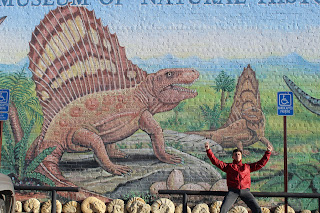Day 4 : Raising bones.
On our fourth day of this magnificent A term, we had an early rise at 7 in the morning to enjoy a delicious breakfast of bacon, eggs, and potatoes. After this, we departed to the Whiteside museum of national history, where we met our paleontology experts Chris, and Holly. They explained to us that some 300 million years ago most of Texas was covered in water, especially the Seymore area. At this time there were a lot of amphibians and other creatures, but mainly among them was the Dimetrodon. This creature was a carnivore that mostly lives on land but sometimes would live in the water. It is classified as a non-mammalian synapsid. He also told us that Seymore is pretty much the best place in the world to find and study them and that that was what we were going to mostly find on our dig today.
After a 20 minute drive to Craddock ranch, which is where the dig site is, we started our Palio work by just walking around, looking at the ground to see how many fossils we could find. It turns out that in that area there were tons of fossils just lying around waiting to be picked up. After that, we started working on some dirt walls to try and excavate some more bones. This was especially interesting because if you found a bone, then you would most find other bone structures connected to it. Another interesting was that we had to dig in a specific layer of dirt because the dirt there was as old as when the Dimetradons had died. Another interesting thing was that we only found Dimetradon bones in the dirt layer, and this was a really cool indication that the Dimetradons were cannibals. This is because they would eat each other, and wouldn't starve from the lack of herbivores to eat.
Another note, India found what Chris said was a world record size Dimetradon femur bone.
At the end of the day, we were all pretty, and headed back to eat food.
The End
Excited to dig up Dimetrodons
World record fossil!
Writer - Jackson Taylor
Photographer - Tyler Holland








Comments
Post a Comment